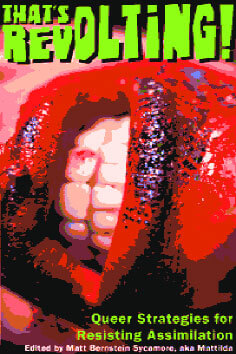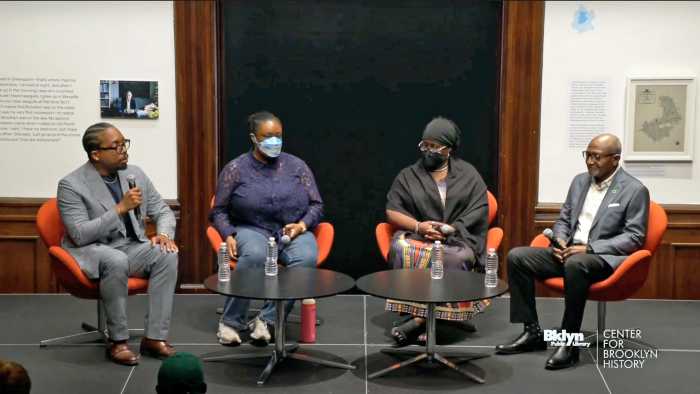VOLUME 3, ISSUE 344 | October 28 – November 3, 2004
Queer Strategies
For Resisting Assimilation
Edited by Matt Bernstein
Sycamore, a.k.a. Mattilda
Soft Skull Press
320 pages; $16.95
Teach Your Parents Well
Young, radical queer writers offer urgent perspectives from the outside
In the new volume, “That’s Revolting!: Queer Strategies for Resisting Assimilation,” editor Mattilda, a.k.a. Matthew Bernstein Sycamore, recounts a moment after Queer Shame, a group of radical activists, has upbraided the organizers of an academic conference for treating them as the token activists, when an aging egghead dismisses their complaints as the hollow echo of arguments about cultural and political appropriation that swirled in 1960s academic circles.
The remarks by the academic are intended to belittle Queer Shame. But, as Mattilda notes, Queer Shame’s aim was to keep the older gay academics and former radicals honest, a time-honored ethical function performed by new, young activists.
Throughout “That’s Revolting,” the sincerity, integrity and sexual energy that young activists bring to their work, as well as the political and practical sophistication such work accords them, informs what the authors describe as a call to action of pissed-off queers seeking as wide an audience as possible. In its exposition of the successes and screw-ups of new queer activism, the book is a primer for radical action.
Jennifer Flynn of the late 1990s’ Fed Up Queers (FUQ) notes, “Many of us were involved in ACT UP in the mid-90s… after that group’s time in the spotlight… I remember always feeling worn down by the long meetings… (T)he frustration… led us to one of the shared values of FUQ: action over discussion.”
FUQ’s visibility and mobility were the result of its understanding that the historical moment required a new group dynamic. If, as the middle-aged academic implied, young queer activists are re-inventing the wheel, they’re also doing their best to improve upon it.
This doesn’t mean the wheel always rolls smoothly. The FUQ members worry that “cliquishness” led to the group’s demise. Mattilda recounts how Gay Shame failed to prepare for the inevitable arrests when they disrupted the San Francisco Pride Parade. The airwave pirates of RadioActive Queers bemoan the difficulties of organizing with more experienced, more macho media independistas.
But the wheel rolls forward. The greatest advance of new queer activists is a “post-identity politics” that rejects the liberal notion of gay rights in favor of the radical concept of universal entitlement. Mattilda critiques a gay rights agenda that “fights for an end to discrimination in housing, but not for the provision of housing, domestic partner health coverage but not universal health coverage… [that] fights for tougher hate crimes laws, instead of fighting the racism, classism, transphobia (and homophobia) intrinsic to the criminal ‘justice’ system.”
He argues that gay assimilation means buying (literally) into the oppressions of mainstream culture and capitalism.
The book insists upon race, class, gender and ability awareness. At stake are necessities like food, shelter and safety as mainstreaming gays join forces with developers, conservative politicians and heterosexual yuppies to marginalize queer and transgendered youth, poor people and communities of color from services and spaces in affluent gay meccas like the West Village and the Castro.
As the activists of “That’s Revolting” make connections between gay ghetto gentrification and Third World disenfranchisement, getting active in anti-globalization and anti-racism movements, they find that coalition-building betters their own queer lives. University of California at Santa Barbara’s PISSAR, People in Search of Safe and Accessible Restrooms, was born at a Student of Color Conference when the disability and transgendered caucuses were so poorly attended that they decided on a joint session, and discovered shared concerns. For one thing, both groups had trouble accessing the campus’ restrooms. Their manifesto describes not only the concrete ways PISSAR works for restroom accessibility, but also how its members developed mutual awareness and support.
PISSAR’s approach has a campy edge; after all, this is potty humor. But that doesn’t discount the seriousness of the group’s mission. Queer activist wit keeps up our spirits, garners attention, disarms the homogenizing mainstream and, in fact, helps keep us alive.
When Queer Shame held their Exploitation Runway on San Francisco’s Fillmore Street, a ballroom extravaganza whose form was popularized by African American and Latino queers, including categories like Gentrification Realness, their “spectacle served to draw people in” so that they could be educated about anti-homeless initiatives. The event’s facetious humor acted as a heavy-duty tool.
Another activist tool, to borrow a metaphor from queer organizers, the Pollinators, is sexual attraction. As every activist knows, guaranteeing a roomful of hotties increases attendance at meetings. But the difference between my 40-something generation and younger activists is their willingness to shatter narrow definitions of identity. As a RadioActive Queer named SalMonella says, the new generation is a “sexy, crazy, balls-out culture,” with a polyamorous libido and a pliable gender continuum.
“(I)n other words,” writes Mattilda, this is “a book by a bunch of freaks, fruits, perverts and whores” arguing that repression is oppression. Patrick Califia writes, “Freaks are entertainers, jesters, satirists, artists, beautiful in a way that few can endure or savor, intelligent in a way that makes others angry.”
Therein lies their self-determining power; they anger because they challenge—politically, intellectually and sexually.
And what does the wider queer community expect? Activists typically are the vanguard of social changes later absorbed by the mainstream. When their ideas find wider support, radical queers up the ante on further challenges
“The radical potential of queer identity lies in remaining outside,” writes Mattilda.
The book includes queer outsiders and outlaws; there are homeless queers, queers in prison and queers in the drug trade represented.
Sometimes the anarchic mix makes for uneasy bedfellows. The book concludes with a writer describing the survival of homeless teens by dealing drugs. Though he admits that the drug trade “strengthens capitalism and its structures of power,” he argues, “Selling drugs kept me fed and kept me from falling into the seductive tales of American success. For queers, people of color, and the poor, success under these terms means serving in the army of assimilation commanded by the white middle and ruling class.”
But the book includes no analysis of the drug trade’s decimation of poor and non-white communities, or its impact on the spread of HIV. In fact, the virus is nearly excluded from the book. Where is the essay about global AIDS activism, the contemporary vanguard of the AIDS movement and the internationalist legacy of ACT UP?
And speaking of ACT-UP, a bit more of the historical would have helped contextualize “That’s Revolting!” It wasn’t just attrition by death and grief, sabotage by the federal government or the development of protease inhibitors that undermined ACT-UP’s viability—it also involved a philosophical struggle between affluent white gay men seeking treatment for themselves and other queers who approached the epidemic by questioning race, class and gender assumptions. In other words, it was the gay mainstream versus the radical “others,” the same folks who have written “That’s Revolting!” That recognition would have informed the many complex issues explored in the book.
Older and more mainstream readers would have benefited from a more explicit exploration of new queer cultural currents. Terms like “genderqueer” aren’t universally understood. The writers seemed aware of the need to carry word of the new queer zeitgeist plainly enough for the “wider audience” to get it. Mattilda could have done more to further that end in his introduction, but instead treats us to his personal history with gay-themed television. “But why am I torturing you with all this crap?” he asks. I had the same question.
Still, we can’t expect a single book—particularly the first of its kind—to convey the whole of a very complex world. As it inveighs against the forces of disempowerment and describes movements toward strength for and by a new generation of radical queers, this is one of the year’s most vital gay reads. Despite its spots of messiness, “That’s Revolting!” is fierce.

































